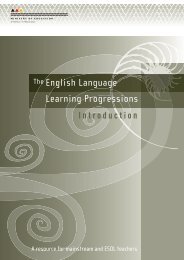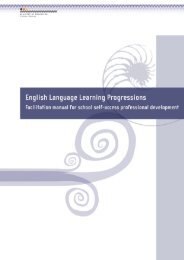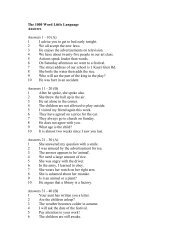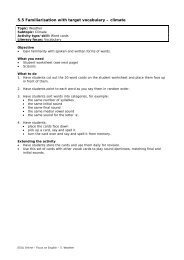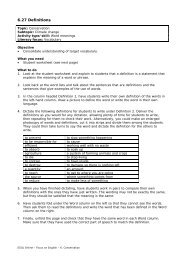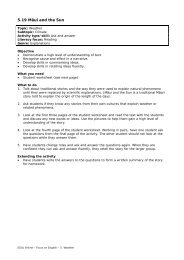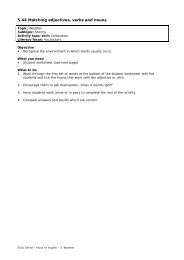ELLP Years1-4 - ESOL - Literacy Online - Te Kete Ipurangi
ELLP Years1-4 - ESOL - Literacy Online - Te Kete Ipurangi
ELLP Years1-4 - ESOL - Literacy Online - Te Kete Ipurangi
You also want an ePaper? Increase the reach of your titles
YUMPU automatically turns print PDFs into web optimized ePapers that Google loves.
Oral Language – Listening gan<br />
and dS<br />
Speaking<br />
Oral language is sometimes assumed to be less complex than written language. Spoken<br />
language that occurs in face-to-face contexts and is about things that the learner can see<br />
is often easier to comprehend than written language that refers to abstract concepts or<br />
unfamiliar ideas. However, oral language can also involve abstract concepts and ideas<br />
that are new to the learner, and (unlike written language) it can’t usually be reviewed<br />
by the listener. Oral language is often as complex as written language and is sometimes<br />
more difficult to process. It challenges the learner in different ways from written<br />
language.<br />
Children learn to speak their first language before they learn to read and write it, and<br />
it’s widely known that they will learn to read and write more easily if they have first<br />
developed a rich bank of oral language. However, unlike a native speaker of English, an<br />
English language learner hasn’t necessarily established an oral language base in English<br />
as part of their development before they start school. An English language learner may,<br />
therefore, not have an existing basis in oral language on which to build English literacy<br />
skills.<br />
What’s different about<br />
speaking and listening in<br />
an additional language?<br />
There are many interrelated factors that may influence an English language learner’s<br />
proficiency in oral language, including:<br />
• the content of their previous English language instruction (if any);<br />
• the teaching approaches used in previous English language instruction (if any);<br />
• the age at which they begin (or began) learning English;<br />
• their level of confidence in speaking English.<br />
English language learners in New Zealand are learning English in a context where it’s the<br />
everyday language of the majority of the community. All new English language learners<br />
face significant challenges when speaking and listening to New Zealand English. At the<br />
same time as they are learning the vocabulary and grammatical structures of the new<br />
language, they’re also working to gain control over other features of oral language. They<br />
need to learn the sounds of English words, the subtle meanings conveyed by changes in<br />
tone and speed, and the differences in meaning that a change in stress can make. (For<br />
example, “refuse”, with the stress on the first syllable, is a noun that means “rubbish”,<br />
but “refuse”, with the stress on the second syllable, is a verb that means “to say no to<br />
something”.) These are called the prosodic features 2 of a language. Prosodic features<br />
combine with non-verbal language features, such as facial expressions, to create and<br />
convey meaning, and both are culturally determined dimensions of the language. It takes<br />
time to learn the significance of the prosodic features of a new language.<br />
Some learners who can already read and write in their first language may learn to do the<br />
same in the new language before they are able to comprehend it orally. This is especially<br />
likely if they first learned English at school in a context where:<br />
• English was not the language of the community;<br />
• teachers focused more on written English than on oral English;<br />
• there were few opportunities to listen to or speak with native speakers of<br />
English.<br />
2<br />
The Cambridge Encyclopedia of Language, by David Crystal, discusses different aspects of spoken and<br />
written language. It explains how the prosodic features of each language differ and how they are<br />
interpreted and expressed in different cultures. Prosodic features are also described in Exploring<br />
Language, Ministry of Education, 1996.<br />
Why can some learners<br />
read and write in<br />
English before they learn<br />
to speak it?<br />
7





